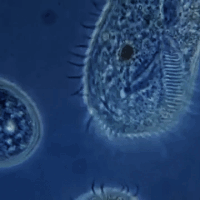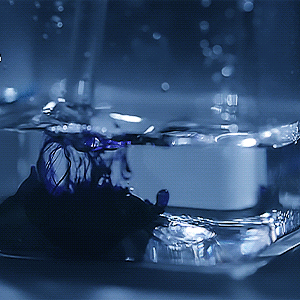#Water and Bacteria
Explore tagged Tumblr posts
Text

Daphnia pulex (Water flea)
Photo credit: Paul Hebert
Source: Functional Genomics Thickens the Biological Plot. Gewin V, PLoS Biology Vol. 3/6/2005, e219. doi:10.1371/journal.pbio.0030219
#daphnia#daphnia pulex#water flea#tricorn#microbiology#microbes#biology#hats#microbes in hats#microorganisms#bacteria#protozoa#microscopy
141 notes
·
View notes
Text
i do not understand how evolution got us to these complex ass systems sometimes. like on paper yes i see the evolutionary tree. but photosynthesis? how did the bacteria know how to do that... how are individual cells smart enough to figure the chemistry of that out. how did we get here why is everything so complicated .
#i want to see what it was like when the very first bacteria accidentally split a water molecule with sunlight#like bitch.. were we just really lucky bc good lird#ramblings
93 notes
·
View notes
Text

Finally got a fancy(tm) pic of my aquarium - think I figured out the solution to awful photos is just I have to do them at night because the hugeass window in my room directly adjacent ruins everything. Going to try and take a pic like this weekly to track growth!
Anyway it's looking close? Closeish? to being cycled so the question is: WHAT COLOUR SHRIMP
#kerytalk#fish nonsense#planted tank#aquablr#fishblr#cherry shrimp or neocaridina is what I'm looking for#I just don't think I'd like reds. Or yellow#also rip I found the underground shrimp trading groups (complicated) and went from not finding any Caridina to so many#DO NOT TEMPT ME! I KNOW THEY'RE MORE SENSITIVE#they look bomb af tho rip#I do prefer them over Neos#idk how close is close but ammonia is 0.2 nitrites 0.0 and nitrates 20ppm#been sitting at that for a hot minute tho so not sure what's happening#dosing with bacteria and a fertiliser (both seachem) daily#things I've read saying as long as I have nitrates it means something is being converted so yay? it's def not in our tap water I tested
181 notes
·
View notes
Text
celsius haters be like "um we don't live our lives according to the temperature of water ☝️🤓"
yes, you do... it's called... weather 🌧️❄️🌈☀️
#0 or negative degrees? it can snow. water can freeze. also a useful shorthand for 'its cold out'#higher than 0? too warm for snow#this informs how you dress and whether you go outside at all#also knowing when water boils (100 celsius) is important for... cooking! boiling water also kills bacteria / makes it safe to drink!#aka information that is extremely crucial to the basics of life
38 notes
·
View notes
Text
A group of bacteria has proved adept at destroying the ultratough carbon-fluorine bonds that give “forever chemicals” their name. This finding boosts hopes that microbes might someday help remove these notoriously pervasive pollutants from the environment.
Nearly 15,000 chemicals commonly found in everyday consumer products such as pizza boxes, rain jackets and sunscreens are recognized as perfluoroalkyl and polyfluoroalkyl substances, or PFASs. These chemicals can enter the body via drinking water or sludge-fertilized crops, and they have already infiltrated the blood of almost every person in the U.S. Scientists have linked even low levels of chronic PFAS exposure to myriad health effects such as kidney cancer, thyroid disease and ulcerative colitis.
Current methods to destroy PFASs require extreme heat or pressure, and they work safely only on filtered-out waste. Researchers have long wondered whether bacteria could break down the chemicals in natural environments, providing a cheaper and more scalable approach. But carbon-fluorine bonds occur mainly in humanmade materials, and PFASs have not existed long enough for bacteria to have specifically evolved the ability to digest them. The new study—though not the first to identify a microbe that destroys carbon-fluorine bonds—provides a step forward, says William Dichtel, a chemist at Northwestern University who studies energy-efficient ways to chemically degrade PFASs.
To identify a promising set of bacteria, the study’s authors screened several microbe communities living in wastewater. Four strains from the Acetobacterium genus stood out, the team reported in Science Advances. Each strain produced an enzyme that can digest caffeate—a naturally occurring plant compound that roughly resembles some PFASs. This enzyme replaced certain fluorine atoms in the PFASs with hydrogen atoms; then a “transporter protein” ferried the fluoride ion by-products out of the single-celled microbes, protecting them from damage. Over three weeks most of the strains split the targeted PFAS molecules into smaller fragments that could be degraded more easily via traditional chemical means.
By directly targeting carbon-fluorine bonds, the Acetobacterium bacteria partially digested perfluoroalkyls, a type of PFAS that very few microbes can break down. Even so, these Acetobacterium strains could work only on perfluoroalkyl molecules that contain carbon-carbon double bonds adjacent to the carbon-fluorine ones. These “unsaturated” perfluoroalkyl compounds serve as building blocks for most larger PFASs; they are produced by chemical manufacturers and also emerge when PFASs are destroyed via incineration.
Scientists had previously demonstrated that a microbe called Acidimicrobium sp. strain A6 could break down carbon-fluorine bonds and completely degrade two of the most ubiquitous perfluoroalkyls. This microbe grows slowly, however, and requires finicky environmental conditions to function. And researchers do not yet fully understand how this bacterial strain does the job.
The Acetobacterium lines target a separate group of PFASs, and the team hopes to engineer the microbes to either improve their efficiency or expand their reach—potentially to more perfluoroalkyls. Lead study author Yujie Men of the University of California, Riverside, imagines the microbes would perform best in combination with other approaches to degrade PFASs. The range of chemical structures in these compounds means “a single lab cannot solve this problem.”
Any future commercial use of the microbes would face numerous hurdles, including breakdown speed and replicability outside of the lab, but Men looks forward to seeing how far her team can push the technique. “We’re paving the road as we go,” she says with a laugh.
35 notes
·
View notes
Text
Love the fact that everyone's acting surprised that the We-Dump-Shit-In-The-Water country has had an outbreak of There's-Shit-In-The-Water disease.
#uk politics#Yeah there's been an e.coli outbreak#And everyone's talking about lettuce for some reason#As if they didn't set out warnings over high levels of THIS SPECIFIC BACTERIA in UK rivers like. Two months ago.#This (literal) shithole of a country just gets worse and worse!#Praying that whoever gets in next stops dumping literal shit in the water because. Um.#Because we don't want shit to be in the water?#I can't believe I'm having to justify this wtf#How do you explain to somebody why you don't want there to be shit in the water#It's ludicrous#John Snow (cholera guy not GoT) is turning in his grave#We've known for what almost two hundred years that dumping shit in water is a bad plan? And what do the tories do.#They dump. Shit. In the water.#I don't even know why they're doing it they Just Are.#fuck the tories#uk news
33 notes
·
View notes
Photo









CiderTalk'84
🤖 💉 🤖 💉 🤖 💉 🤖 💉
#dr cidertalk#cidertalk'84#chipspeech#vocaloid#stim#stimboard#moodboard#my stims#blue#dark blue#navy blue#doctor#robot#machine#mechanical#computer#water#bacteria#tech#technology#glow
226 notes
·
View notes
Text
Got "gifted" a black moor goldfish and I need some advice...
So like obvious tw for animal abuse but my coworker just deposited her fish on my desk and told me it's mine now because I "know about fish keeping" and this fish is "abusive" to her other one (lol it's eating the other one bc it was in a 5 gallon tank) and I'm having like the fucking 5 stages of grief bc I'm not prepared to take care of her fish (I HAVE 2 CATS AND SHE KNOWS THIS WTF) but I feel like it'd be actually evil to give it back to her and I'd incur a horrific karmic debt for doing so, so I'm sitting here with a fish on my desk staring at me with its big vulnerable eyes and I feel awful


I'm buying an API freshwater master kit, seachem prime, an air stone, and a 10 gallon tank with a new filter tonight but does anyone know anything about black moor goldfish?? I know it'll eventually end up in a 15 gal tank but I can't do that right now due to space + weight constraints. My coworker gave me a 2.5 gal tank and it'll be in that until I can acquire the 10 gal tank. Eventually I plan on going with a walstad method tank (when I'm able to get a spare fucking 3 months to set it up lol) but until then I am going to be doing emergency fish-in cycling with no plants and minimal decorations. I have gravel substrate but I'm not sure if I want to use that yet. Can anyone offer advice and recommendations on helpful products?
#slime speak#fish#fishposting#also for reference the water is currently clean with no nitrates nitrites or ammonia but i know its not bacteria rich water#i only used hach test strips that are available at my job bc we dont have hach test n tube for that which is what i wouldve used
16 notes
·
View notes
Text

done for the day thank you!!!
#mackintosh#i have been furiously cleaning in short bursts bc guess who’s been regurgitating under the futon?#i scrubbed down that area and put the cover in the wash and scrubbed down the food area#ive also been slowly moving the food farther from the front door bc maybe thats stressing her out??#i changed the water dishes but have yet to really scrub down that area bc there’s so many hard water stains#i also am stopping the storage of kibble in their broken automatic feeder bc it’s hard to clean and maybe it’s picking up bacteria in there#somehow? i have a lovely crock to put their kibble in and i need to find a pretty smaller airtight container instead of the huge waterproof#their whole bag of kibble goes in#im also going to try to wash the candle out of the other couch cushion ive ignored it long enough#😬😬😬
14 notes
·
View notes
Text

I wonder?
Are there "bacteria" on the Sun?
and
What would their purpose be?
By the way,
Bacteria can survive in sulphuric acid and "heavy water" in nuclear power stations and extreme heat conditions ... bacteria facts
#bacteria#bacteria facts#sun#questions#heavy water#heat#hot conditions#extreme heat#world#australia#america#tumblr#nature#william
10 notes
·
View notes
Text

Tardigrade/Water Bear Species: Acutuncus antarcticus
There are approximately 1,300 known species under the phylum Tardigrada. They are found almost anywhere, including mountaintops, tropical rainforests, the deep sea, and the Antarctic. They are extremophiles, capable of surviving a few minutes at both 151°C (304°F) and −272°C (−458°F; 1 K) and a few days at −200°C (−328°F; 73 K).
This particular Antarctic species has been found to be able to survive for 30 years at −20°C (−4°F). (Tsujimoto et al. 2016 Cryobiology)
Photo credit: Megumu Tsujimoto/NIPR
#tardigrade#tardigrades#water bear#acutuncus antarcticus#microbiology#microbes#biology#hats#microbes in hats#microorganisms#bacteria#protozoa#microscopy
106 notes
·
View notes
Text

this was literally the only question i was curious about, thanks for asking that for me paimon
like fontainain people married other nationalities yeah?? how did they have kids if they were oceanids.. anddd umm if they could fuck normal humans wouldn’t that make the oceanid in springvale falling in love with a boy from mond a bit problematic lol especially since it’s no longer a fairytale but an actual thing that happened and we witnessed it last patch??
so it’s not the case and new oceanids are just turned into humans but wait!! so celestia allows that?? it keeps constantly happening but they’re not stopping it.. ok sure but also
i wonder how many generations of fontaine people will it take for them to realize that they have to sexually mate to create children now
#is this too weird to think about??#like i wasn’t constantly thinking about this but the moment i saw the first slate during furina’s trial i was like so are fontainians..#recycled oceanids or do they like propagate like bacteria#y’know.. as a biology major#my first thought was when a ‘human’ dies the oceanid that was them would loose their memories and be reborn as a new person#but then i thought like ok but they think they’re normal humans so wouldn’t it be weird to see other humans get pregnant conceive while#fontainians get their babies in mail?? and what if a fontainian is married to someone from a different nation.. this doesn’t make sense#and also another thought related to navia’s obsession with that cemetery#so umm y’know how we bury the dead in the ground as a way of returning them to where they came from.. and it is a natural process that..#recycles nutrients and natural sources to the planet yeah? so wouldn’t make more sense for fontaine people who were born from water to#return to water as well?? i just find having a cemetery a bit strange in this case#i only had this thought bc silver and melus couldn’t be buried and i was like.. none of u should#it is their belief that they’re born from water and will naturally return to it from what i understood doing the first two chapters#this train thought is getting out if hand i need to stop#genshin impact#genshin spoilers#genshin navia#neuvillette#fontaine archon quest
39 notes
·
View notes
Note
hey um not to be parasociall but how did the meeting with your advisor go???? also would it be possible for you to switch advisors/program or something so you can change your research interests if that's the issue? Im a doctoral student as well so I get how tricky that stuff can be depending on your program.... Anyway I hope things better for you xoxo
Lol, ur fine! It went alright
#basically i just told him ive been paralyzed from working on my project out of fear from what happened when i had a breakdown in april#which is true but is still an incomplete picture of whats happening. and he was like yeah thats understandable. let me kno what i can do to#help. so that was good. tho he did look a bit deer in headlights lol#and ive started reading project relevant papers again and i understand what theyre saying which is good#i feel like im behind where i should b but im also like: ok right i do actually think this is interesting. evolution is sick as fuck#but i wouldnt want to switch advisors bc hes like one of 2 bacteria ppl in the department#i would have to go to a different school to do what i want with eps. either like a industry focused lab interested in slime as#like a thickener. which sounds boring. or go back to my old boss who is desert ecology focused#its just a matter of: do i really want to b an Evolutionary microbiologist? a very academic job? or do i want a job that's just a job?#and like maybe to stay with cyanos i would have to leave and then go back to school to focus on toxic algal blooms#then i could probably get water quality jobs. but like would that b fulfilling? idk. it just sucks#bc i fit in so well with my lab interest wise. its just a matter of whether or not i want my Job to b my whole life#unrelated
8 notes
·
View notes
Text
taking a turian to a waterpark on the worst first date ever
#☆turians#☆galactic species#if they don't drown then they die from poisoning hours later from accidentally ingesting human bacteria infested waters
9 notes
·
View notes
Text

TSRNOSS, page 157.
#lanthanide mineral#Madagascar#lanthanide ion#liquid laser#EDTA#action potential#conduction velocity#calcium hydroxide#cerium ion#soft water#atherosclerosis#bacteria#mutation rate#Cambrian explosion#europium#ammonia solubility#transition metal ions#oxygen#paramagnetism#half-filled orbitals#stability#cell#manuscripts#notebooks#diaries#theoretical biology
4 notes
·
View notes
Text
took monday off because it's the 14th (!? holy shit) anniversary of my mom's death and i dont even know what to do with 2 days off anymore
#personal#i was gonna go to the beach but the beach is closed bc too much bacteria in the water 🙁#so idk lol
13 notes
·
View notes